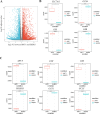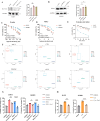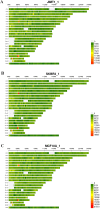Targeting SLC7A11-mediated cysteine metabolism for the treatment of trastuzumab-resistant HER2-positive breast cancer
- PMID: 40464376
- PMCID: PMC12136593
- DOI: 10.7554/eLife.103953
Targeting SLC7A11-mediated cysteine metabolism for the treatment of trastuzumab-resistant HER2-positive breast cancer
Abstract
Trastuzumab resistance remains a challenge for HER2-positive breast cancer treatment. Targeting metabolic reprogramming would provide novel insights for therapeutic strategies. Here, we integrated metabolomics, transcriptomics, and epigenomics data of trastuzumab-sensitive and primary-resistant HER2-positive breast cancer to identify metabolic alterations. Aberrant cysteine metabolism was discovered in trastuzumab primary-resistant breast cancer at both circulating and intracellular levels. The inhibition of SLC7A11 and cysteine starvation could synergize with trastuzumab to induce ferroptosis. Mechanistically, increased H3K4me3 and decreased DNA methylation enhanced SLC7A11 transcription and cystine uptake in trastuzumab-resistant breast cancer. The regulation of epigenetic modifications modulated cysteine metabolism and ferroptosis sensitivity. These results revealed an innovative approach for overcoming trastuzumab resistance by targeting specific amino acid metabolism.
Keywords: HER2-positive breast cancer; cancer biology; cysteine metabolism; epigenetic modifications; human; mouse; trastuzumab primary resistance.
© 2025, Hua, Duan et al.
Conflict of interest statement
YH, ND, CS, FY, MT, YS, SZ, JG, QL, XH, YL, ZF, WL, YY No competing interests declared
Figures






















Update of
- doi: 10.1101/2024.11.12.623302
- doi: 10.7554/eLife.103953.1
- doi: 10.7554/eLife.103953.2
References
-
- Badgley MA, Kremer DM, Maurer HC, DelGiorno KE, Lee H-J, Purohit V, Sagalovskiy IR, Ma A, Kapilian J, Firl CEM, Decker AR, Sastra SA, Palermo CF, Andrade LR, Sajjakulnukit P, Zhang L, Tolstyka ZP, Hirschhorn T, Lamb C, Liu T, Gu W, Seeley ES, Stone E, Georgiou G, Manor U, Iuga A, Wahl GM, Stockwell BR, Lyssiotis CA, Olive KP. Cysteine depletion induces pancreatic tumor ferroptosis in mice. Science. 2020;368:85–89. doi: 10.1126/science.aaw9872. - DOI - PMC - PubMed
-
- Bailey SD, Desai K, Kron KJ, Mazrooei P, Sinnott-Armstrong NA, Treloar AE, Dowar M, Thu KL, Cescon DW, Silvester J, Yang SYC, Wu X, Pezo RC, Haibe-Kains B, Mak TW, Bedard PL, Pugh TJ, Sallari RC, Lupien M. Noncoding somatic and inherited single-nucleotide variants converge to promote ESR1 expression in breast cancer. Nature Genetics. 2016;48:1260–1266. doi: 10.1038/ng.3650. - DOI - PMC - PubMed
MeSH terms
Substances
Associated data
- Actions
Grants and funding
- 81972484/National Natural Science Foundation of China
- 82272667/National Natural Science Foundation of China
- 82203488/National Natural Science Foundation of China
- JX102GSP201727/High-level Innovation Team of Nanjing Medical University Program
- JX21817902/008/The Collaborative Innovation Center for Tumor Individualization Program
LinkOut - more resources
Full Text Sources
Medical
Research Materials
Miscellaneous

